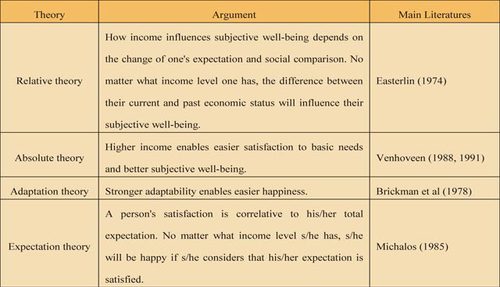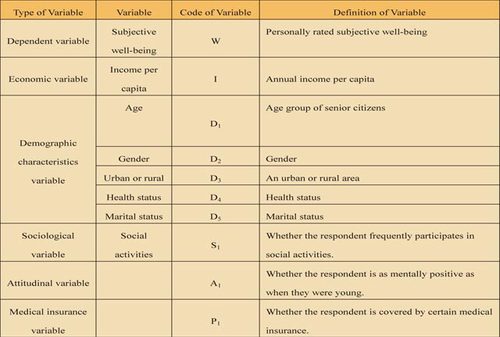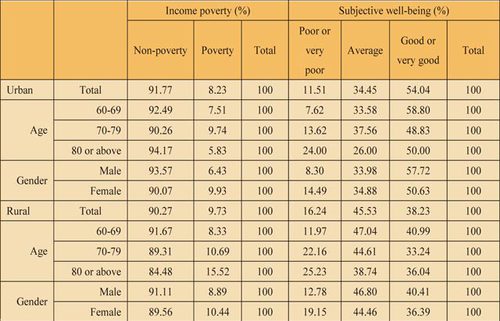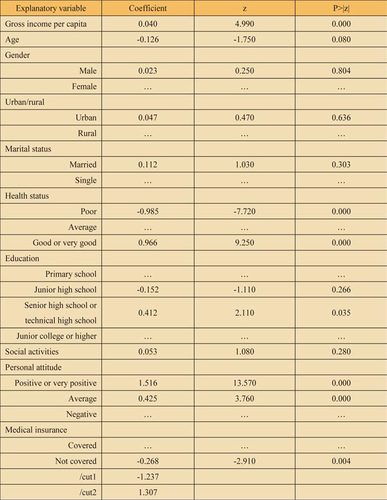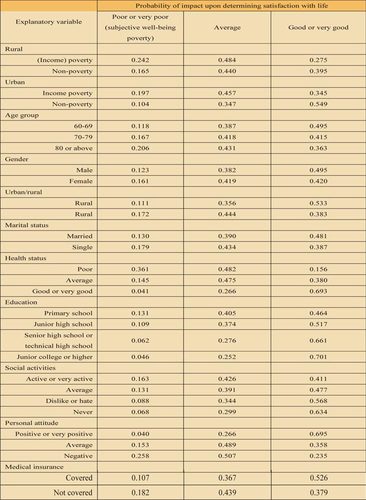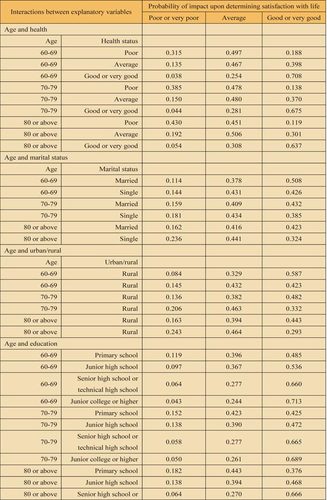2010.02-Working Paper-Subjective Well-being Poverty of the Elderly Population in China
AbstractA
Poverty is represented not only by objective well-being indicators which include income and consumption levels, but also by subjective indicators which reflect what a person feels. It is estimated in this article that the inci-dence of subjective well-being poverty among the Chinese rural elderly popu-lation in 2006 was 9.7 per cent, about 4.2 times as much as that among the country's total rural population in the same year, which was 2.3 per cent. Over sixteen per cent of the rural elderly population and 11.5 per cent of the urban elderly population rated their life satisfaction as poor or very poor. In terms of subjective well-being poverty, senior citizens, especially those who live in rural areas or who are women or very aged, have become a special group among the poor in China. This article suggests that China's social policies for the new stage take into account the issue of absolute poverty and also that of subjec-tive well-being poverty. A multidimensional strategy system targeting the issue of poverty needs to be established, and a policy system to address poverty reduction as well as old age security and care should be implemented.
Keywords: Subjective well-being; Poverty; Elderly population; China
1. Introduction
The United Nations has included poverty reduction in its Millennium Development Goals as a primary measure of each country's development. This is one of the main goals for every country to consider when it designs poverty reduction and social development policies, and should be a main indicator to evaluate the performance of its policies. However, the main indicators now used in the world to assess poverty are based on income level. Such indicators for assessment result in the focus of poverty reduc-tion policies centring on lowering the incidence of income poverty by promoting the purchasing power of the people (Rojas, 2007).
After the incidence of income poverty is largely reduced, the rapid aging of population makes the well-being status of the elderly population an increasingly important social issue that the Chinese government must face according to the following fundamental analysis of China's economic and social development.
Firstly, China has a rapidly aging society, which introduces major changes in its economy and society in terms of both the workforce struc-ture and consumption structure. As the number of senior citizens grows, their well-being and poverty status will have more impact on the well-being status and poverty reduction of the entire society.
Secondly, China is experiencing a dramatic income and wealth polar-ization. In the past 30 years, China has reduced its population living in absolute poverty by implementing the economic reforms and opening-up policy as well as through government-led and development-oriented pov-erty reduction strategies. According to China's official poverty standards, its population living in poverty was reduced from 250 million in 1978 to 40.07 million at the end of 2008 (National Bureau of Statistics of China, 2009). As the national income rapidly increases, the development gap between urban and rural areas widens, and wealth polarization becomes more pronounced. In 2008, the income ratio between urban and rural resi-dents in China expanded from 3.3 to 1, and the urban-rural income gap exceeded 10,000 yuan for the first time. The disparity between urban and rural areas is greater if different accessibility to public services is taken into account. According to the World Bank's World Development Report 2006, 94 out of the 127 countries included had Gini coefficients lower than that of China. Because of such a wealth polarization, the subjective well-being poverty among the Chinese people is growing. While people have higher income, they recognize themselves as having less subjective well-being (their perceptions of well-being or life satisfaction) and more relative depri-vation. For a society that does not largely promote its general subjective
well-being, the reduction of its income poverty will neither create a significant improvement in its overall level of social welfare nor help the building and sustainable development of a harmonious society.
Thirdly, in the social development of China, the population of older people living in poverty is a special social group facing multiple vulnerabili-ties, which cannot be resolved with social policies that are designed only to overcome income poverty.
Therefore, the research on subjective well-being poverty among the Chinese urban and rural elderly population and its influencing factors bears major policy implications for the Chinese social welfare policies that are targeted at elderly people in urban and rural areas and to the poverty reduc-tion strategies that the Chinese government is implementing on develop-ment and social security. Furthermore, it will be helpful to building a harmo-nious society to include subjective well-being as one of the indicators to monitor the performance of poverty reduction. In the first part of this article, a conceptual framework is built for subjective well-being poverty and its measurement method. In the second part, the subjective well-being status of the Chinese elderly population is described and statistically analysed. Thirdly, influencing factors to subjective well-being poverty among the elderly people are interpreted with an ordered logit model, and finally, the paper provides the appropriate conclusions and policy recommendations.
2. Literature Review and the Conceptual Framework
2. 1 Multiple dimensions of poverty
While poverty reduction and a higher level of human well-being have always been the primary goals that all countries pursue in their development policies, there have been no standard definitions available for the concepts of poverty reduction and human well-being. Initially, human well-being was primarily concerned with the dimension of income, which is a single objective dimension. The initial concern about poverty was also based on income or consumption per capita. In the past two decades however, public concerns about human well-being have shifted from a single dimension to multiple dimensions. According to Sumner's conclusion in 2006, public concerns about human well-being have expanded from the original single dimension of income to multiple dimensions including society, environment and human rights (Sumner, 2006). More generally accepted now is the concept of multi-dimensional well-being, which includes various aspects of human life (McGillivray and Clarke, 2007). Accordingly, public concerns about poverty have also expanded from the income-based traditional dimension to multiple dimensions (Alkire, 2007). From the central point of view of multidimensional poverty, the measurement of human poverty does not only include the indi-cator of income poverty, but also other objective poverty indicators such as the lack of a potable water supply, road conditions and health facilities as well as the poverty in terms of subjective perception of well-being (Wang andAlkire, 2009).
The latest development with regards to the concepts of well-being and poverty has been the change from the standard of objective well-being and absolute poverty to that of subjective well-being and relative deprivation. A new approach emerging globally is to research poverty from the perspective of subjective well-being. Amartya Sen (1999) regarded human development as a process to expand people's substantive freedoms, where the substan-tive freedoms include basic capabilities that consist of functionings such as avoiding hunger, malnutrition, avoidable diseases and premature death. He regards poverty as a deprivation of basic capabilities instead of simply low income. Sen's approach to define poverty is known as the capability approach.
2. 2 Subjectivity of poverty
There are two perspectives from which the development of human well-being can be measured; objective well-being, what each individual has obtained in the society, such as net income per capita; and subjective well-being which is each individual's subjective evaluation of their life conditions.When a large proportion of people in the world are in objective poverty, such as income poverty, both governments and researchers focus most of their efforts on the improvement of objective well-being. Similarly, when the global incidence of income poverty decreases and income distribution becomes wider, more emphasis is placed on the assessment of and research on sub-jective well-being. In some countries such as Australia, Canada, France, Germany, Italy, New Zealand and UK, policy makers are trying to measure life satisfaction as a part of well-being (Samman, 2007) and to make social policies appropriate to this measurement.
Subjective well-being theories argue that the well-being level evaluated by each individual can more easily reflect the well-being conditions for that individual, while objective well-being indicators such as economic well-being are indicators typically selected by experts or policy makers and therefore are subject to subjective discretion (Rojas, 2004).
Subjective well-being refers to well-being based on personal judgment (Rojas, 2004), which is usually a judgment about life satisfaction and the individual’s perception of well-being. The concepts of life satisfaction and happiness are well distinguished in psychology, but they are often inter-changeable concepts in the language of economists (Samman, 2007).
The judgment of life satisfaction and sense of well-being depend on both economic factors and non-economic factors. There are four subjective well-being theories that are generated based on different influencing factors; the absolute theory, relative theory, adaptation theory and expectation theory (Table 1). The absolute theory and relative theory judge life satisfac-tion or the sense of well-being mainly from the perspective of income, while the adaptation theory and expectation theory do the same mainly from a non-economic perspective.
Absolute theory: The sense of well-being or life satisfaction goes up when absolute income increases. However, the increase of the perception of well-being or life satisfaction is in descending proportion instead of direct proportion to the increase of absolute income (Frey and Stutzer, 2002). In addition, income holds different value in different countries (Kingdon and Knight, 2004).
Much of the academic literature shows that there is a correlation between life satisfaction and household income, but the increase of income only imposes a short-term influence on one's life satisfaction. Long-term surveys in many countries have found that, when income per capita grows, life satisfaction or the perception of well-being does not change as greatly(Krueger and Schkade, 2007). For example, the situations based on a time sequence in the USA and Japan show that the value of happiness does not change at all when actual income per capita increases over time (Easterlin, 2001).
Relative theory: The perception of well-being or life satisfaction relies on relative income. People tend to compare their current income and consumption with that of others or with that of themselves in the past, and their
2. 3 Conceptual framework
We developed the following basic hypotheses based on the above litera-ture review.
1. The subjective well-being of elderly people will increase when their income increases, but the increase of subjective well-being is not necessarily in direct proportion to the increase of income (The absolute theory).
2. In China, it is likely that the subjective well-being evaluation of rural elderly population is lower than that of urban elderly population; and similarly, the subjective well-being poverty of single senior citizens is poorer than that of those who have spouses.
3. The positive life attitude and strong adaptability of a senior citizen positively influences their subjective well-being, and a more positive attitude enables a higher level of subjective well-being (The adaptation theory).
In this article, issues are investigated and survey data from Chinese families used for the purpose of verifying how relevant the above hypotheses are to the subjective well-being poverty of Chinese urban and rural elderly populations. In addition, it will also look at how the social policy of health security influences the subjective well-being of the elderly population.
3. Model and Data
3. 1 Model
In this article, the following econometric model is built on basis of the above basic assumptions.
W = β + β I + β D+ β S+ β A + β P + ε (1)
Where:
'W' is a dependent variable representing subjective well-being of the elderly population. There are five explanatory variables for subjective well-being of senior citizens; income per capita, demographic characteristics, sociological, attitudinal, and social policy.
'I' represents annual income per capita.
'D' is a demographic variable that influences well-being, including gender, age, marital status and so on.
'S' is a sociological variable representing the membership of a social network, cooperative society, association or any other organization.
'A' is an attitudinal variable that reflects a personal life attitude.
'P' is a social policy variable showing, for example, whether a person is covered by certain medical insurance.
'β' is a parameter to be estimated, and;
'ε' is a residual term.
3. 2 Data and variables
The data used in this article is from China Health and Nutrition Survey (2006). The sample covers 2,344 senior citizens distributed in nine prov-inces located in the northeast, east, middle and western parts of China. The term ‘senior citizens’ in this article refers to those who are 60 years old or older1. In this article, each individual person is used as a unit for analysis.
A Life Satisfaction Scale is used in this article to rate subjective well-being of senior citizens. The well-being status is personally rated into three levels; poor or very poor, average and good or very good, which are repre-sented by 1, 2 and 3 respectively, where 'poor or very poor' (1) indicates poverty.The demographic characteristic variables include age, gender, urban or rural location, marital status and education. There are three age groups, where Group 1 includes citizens of 60-69, Group 2 includes those of 70-79, and Group 3 includes those of 80 or older. For gender, 0 represents 'female' and 1 represents 'male'. For urban or rural areas, 1 represents an 'urban' area and 0 represents a 'rural' area. For marital status, 0 represents 'single' and 1 represents 'married'. For health, 0 represents 'poor', 1 represents 'average', and 2 represents 'good or very good'. For education, 1 represents 'primary school', 2 represents 'junior high school', 3 represents 'senior high school or technical high school', and 4 represents 'junior college or higher'. The sociological variable is expressed by how a respondent participates in social activities, where 0 represents 'never', 1 represents 'dislike or hate', 2 represents 'average', and 3 represents 'active or very active'. For the attitu-dinal variable, 0 represents 'negative', 1 represents 'average', and 2 repre-sents 'positive or very positive'. The social policy variable is expressed by medical insurance coverage, where 0 means 'covered' and 1 means 'not covered'.
Table 3 provides statistics on the income poverty and subjective well-being poverty of Chinese elderly people based on the sample data. The incidence of income poverty among rural senior citizens is 9.73%, higher than that of 8.23% among urban senior citizens.In regards to age, respondents who were 70-79 in urban areas have the highest incidence of income poverty, while in rural areas older senior citizens have the higher incidences of poverty.In regards to gender, senior women have higher incidences of poverty than senior men.
When the subjective well-being status is "poor or very poor", it is deemed subjective well-being poverty.
Table 4 provides statistics on the conditions of health, education,social activities and social policies among Chinese elderly people based on the sample data. There are distinct differences between the conditions of urban elders and those of rural elders. The percentage of urban elders with "Good or very good" health conditions is higher than rural elders; the education background of urban elders is better than that of rural elders;more urban elders like to participate in social activities and are more likely to feel happy.
In consideration of the nonlinear relationship between subjective well-being and income, we use a logic model to regress Equation (1). Since the variable W is an ordinal variable dependent on three types, we use an ordered logit regression to estimate the model
Pi = E(W =1| Xi ) = 1+1e−W
Pi = E(W = 2| Xi ) = 1+1e−W
Pi = E(W = 3| Xi ) = 1+1e−W
Based on estimation using maximum likelihood ordinal logistic, Table 5 provides the optimal estimation results of the model. There are 2,200 observed values that are valid for the model. The chi-square value is 736.52, and Prob > chi2 = 0.0000, showing significance of the model as a whole. For each of the variables in the model such as gender (male), urban or rural (urban), marital status (married) and education (junior high school), the asymptotic z-tests indicate that these variables are not individually significant. For the ordered logit regression however, the asymptotic z-tests are not accurate enough, and more accurate likelihood ratio tests are required. The likelihood ratio tests show that the removal of any variable from the model does not make any significant difference to the model as a whole, suggesting that these variables have significant influences to subjec-tive well-being.
Note: The unit for income is RMB 1,000
The estimated coefficient on income is 0.040, which is quite different from 0 and bears statistical significance. Its plus sign means that there is a positive correlation between income and subjective well-being. The coefficient on income indicates that, with other conditions unchanged,for each 1,000 yuan added to annual income per family member the odds ratio for the senior citizen to rate their subjective well-being highly will increase by 0.040 accordingly. The small value of the coefficient on income suggests that the increase of income have positive but limited influence on the subjective well-being of a senior citizen, which validates the Assumption
The positive coefficient on marital status suggests that having a spouse positively influences the subjective well-being of a senior citizen as com-pared to being single. The positive coefficient on urban or rural locality sug-gests that living in an urban area positively influences the subjective well-being of a senior citizen as compared to living in a rural area, which validates Assumption 2. The negative coefficient on age means that a very aged senior citizen tends to rate their subjective well-being poorer than other senior citizens, suggesting that getting older negatively influences subjective well-being s. A negative coefficient on health suggests that poor health negatively influences the subjective well-being of a senior citizen as com-pared to better health. The negative coefficient on education suggests that a lower level of education negatively influences the subjective well-being of a senior citizen as compared to a higher level. Not being covered by a medical insurance negatively influences the subjective well-being rating of a senior citizen as compared to being covered.
Among various influencing factors to subjective well-being of senior citizens, personal life attitude contributes most, followed by health and then education. The coefficient on a 'positive or very positive' personal attitude is 1.516 and an 'average' one is 0.425, suggesting that personal life attitude greatly influences the subjective well-being rating of a senior citizen, which validates Assumption 3. The coefficient on 'good' health is 0.966 and on 'poor' health is -0.985, suggesting that health greatly influences the subjec-tive well-being rating of a senior citizen.
In the logic model, the coefficients on explanatory variables express odds ratios instead of directly explaining the changes of dependent vari-ables. For example, the coefficient 0.049 on income expresses that, for each unit added to the income, the odds ratio for a high rating of subjective well-being will increase by 0.049 accordingly. Since an odds ratio does not provide any explanation about the relationship between income and subjec-tive well-being, it is necessary to determine the probability for independent variables to influence dependent ones, as follows:
Pr(w = 1) = P (W+ μ ≤ cut1) = P (W+ μ ≤ −2.000766) (3)
Note: The 2006 urban poverty line of RMB 1,194 is based on the urban poverty line (RMB 1,251) defined by the World Bank in 2007, adjusted according to the inflation rate of 4.8% in 2007. The rural poverty line is RMB 693 announced by the Chinese government in 2006.
Table 6 shows the probabilities of impact of various explanatory vari-ables upon the subjective well-being of elders. In terms of income poverty, according to Table 5 the household per capita income has positive impact on elders' subjective well-being, but the coefficient value is small. In Table 6, among rural elders with rating life satisfaction as "Good or very good" the subjective well-being values of poverty and non-poverty elders are 0.275 and 0.395 respectively, while the values for urban poverty and non-poverty elders are 0.345 and 0.549, respectively. This suggests that regardless of being urban or rural, poverty and non-poverty exert different levels of impact upon elders' subjective well-being values, and poverty does affect elders' subjective well-being.
From the perspective of age, the older a senior citizen is the lower the probability value for their subjective well-being. For example, senior citizens above the age of 80 have the lowest probability value 0.363 for subjective well-being. This means that a senior citizen who is older will have a lower life satisfaction.
From the perspective of probability values for subjective well-being in relation to different variables, the values are higher for male senior citizens than for female ones, higher for those living in urban areas than for those living in rural areas, higher for those who have spouses than for those who are single, higher for those who are active in social activities than for those who are not and higher for those who are covered by medical insurance than for those who are not.
In addition, the values for subjective well-being of senior citizens widely differ depending on their health conditions, personal attitudes and education levels. The probability values for subjective well-being are 0.156 and 0.693 respectively for senior citizens who have 'poor' health and for those who have 'good or very good' health, which indicates how satisfied senior citizens are with their life largely depends on how healthy they are.
The probability values for subjective well-being are 0.695 and 0.235 respectively for senior citizens who have 'positive or very positive' personal attitudes and for those who have 'negative' ones, which indicates that those senior citizens who have a more positive attitude will have higher life satis-faction.
In terms of education, better educated senior citizens can be more satisfied with their life. For example, the probability values for subjective well-being are 0.464 and 0.701 respectively for the senior citizens who have 'primary school' education and for those who have 'junior college or higher' education.
The interactions between various variables are shown in Table 7.
5. Main Conclusions and Policy Proposals
5. 1 Main conclusions
Analysis in this article finds both considerable income poverty and sub-jective well-being poverty among the elderly population in China. As one of the poorer groups in China, senior citizens require additional support. This article provides a new perspective for China's poverty analysis by switching poverty standards from the objective dimension to a combination of objec-tive and subjective dimensions, and by measuring the increasing subjective well-being poverty of the elderly population in China.
The following conclusions can be drawn from empirical analysis.
There is a positive correlation between income and subjective well-being Senior citizens who have higher income will have higher subjective well-being values. However, the influence coefficient of income to subjective well-being is limited. In terms of income poverty standards, whether a senior citizen is in poverty influences their subjective well-being to a certain degree. Again from the perspective of income and subjective well-being, income is more sensitive to subjective well-being for senior citizens whose income is below the poverty line than for those whose income is above the poverty line. This implies that the poverty line is equivalent to an approxi-mate threshold on the function curve of income and subjective well-being.Above this threshold, the probability is relatively low for the increase of income to improve subjective well-being. By using the Chinese data, this verifies the hypothesis that there is a positive correlation but not a linear relationship between income and subjective well-being.
Subjective well-being is lower for female senior citizens than for male senior citizens, lower for senior citizens who live in rural areas than for those who live in urban areas, and lower for senior citizens who are single than for those who have spouses.
Health status occupies the largest coefficient, showing that health is very sensitive to subjective well-being poverty. The urban and rural medical security system that China is building bears important policy significance for improving the subjective well-being status of the Chinese elderly popula-tion.
Personal attitude imposes a very evident influence on the subjective well-being of senior citizens. Their life satisfaction can be largely improved through promoting their positive attitude.For senior citizens, there is no way to change their educational level achieved in the past. Nevertheless, community-based schools and other social activities for senior citizens can play an important part in improving their subjective well-being status.
5. 2 Policy suggestions
1. The Chinese government is working out the Development-oriented Poverty Reduction Program (2011-2020). When the population in absolute poverty is largely reduced in China, a multidimensional poverty identifica-tion mechanism needs to be established in new poverty-reduction strate-gies and social policies in order to target senior citizens living in poverty. Overall arrangements should be made for many initiatives including poverty reduction, endowment insurance, social relief, and care services for senior citizens.
2. Senior citizens are becoming a special group among the Chinese population in poverty. In the elderly population, those who are the oldest old, living in rural areas, female, or less-educated need to be focused on in poverty reduction strategies and social development policies. Oldest old female senior citizens who live in rural areas, especially those who have low levels of education, will become a vulnerable group that needs special concern. In public policies not only endowment insurance but also appropri-ate care services need to be included. Better development-oriented poverty reduction now will be helpful for reducing income poverty and subjective well-being poverty of the elderly population in the future.
References
Alkire, S (2007), "The Missing Dimensions of Poverty Data: Introduction to the Special Issue", Oxford Development Studies, Taylor and Francis Jour-nals, 35(4), p 347-359.
Brickman, P., Coates, D., Janoff-Bulman, R. (1978), "Lottery winners and accident victims: Is happiness relative? ", Journal of Personality and Social Psychology, 36, 917-927.
Easterlin, R.A. (1974), " Does economic growth improve the human lot? Some empirical evidence", In David PA. & Melvin, W.R. (eds.) Nations and households in economic growth. Palo Alto, Ca: Stanford University Press.98-125.
Easterlin, R.A. (2001), "Income and happiness: Towards a unified theory",
Economic Journal, 111, 465-484.
Fery, B. and A. Stutzer(2002), "What can economists learn from happiness research?", Journal of Economic Literature, XL, 402-435.
Fuentes, N. and M. Rojas (2001), "Economic Theory and Subjective well-being Mexico". Social Indicators Research, Kluwer Academic Press, The Netherlands, Marzo. Pp1-31.
Kingdon, G. G. and J. Knight (2004), "Subjective well-being poverty versus income poverty and capabilities poverty?", GPRG-WPS-003.
Krueger A. B., D. A. Schkade (2007), "The Reliability of Subjective Well-Being Measures", CEPS Working Paper No. 138 January.
McGillivray, M. and Clarke, M (2006), eds. Understanding Human Well-Being NEW YORK: United Nations University Press.
Michalos, A.C. (1985), "Multiple discrepancies theory (MDT) ", Social Indi-cators Research, 16(4), pp.347-413.
National Bureau of Statistics of China (2009), Statistical Communiqué of the People's Republic of China on National Economic and Social Development in 2008, Beijing: China Statistics Press.
Rojas, M.(2004), "Well-being and the complexity of poverty: a subjective well-being approach", WIDER Research Paper, 2004:29 .
Rojas, M. (2009), "Enhancing Poverty-abatement Programmes: a Subjective Well-being Contribution", Applied Research in Quality of Life,4:2), 179-199.
Samman, E. (2007), "Psychological and subjective wellbeing: A proposal for internationally comparable indicators", OPHI Working papers series, Univer-sity of Oxford, pp1-54.
Sen, A. (1999), Development as Freedom, Oxford:Oxford University Press. Sumner, A. (2006), "Economic Well-being and Non-economic Well-being", In McGillivray, M. and Clarke, M (2006) .
Veenhoven, Ruth (1988), "The Utility of Happiness? ", Social Indicators Research, 20: pp.334-354.
Veenhoven, Ruth(1991), "Is Happiness Relative? ", Social Indicators Research 24: pp. 1-34.
Wang, X. and S. Alkire (2009), "The Measurement of Chinese Multidimen-sional Poverty: Estimates and Policy Implications ", Research Report, No. 1, International Poverty Reduction Center in China.
World Bank (2000), World Development Report 2000/2001: Attacking Pov-erty. Washington, DC: World Bank.
World Bank (2006), World Development Report 2006: Equity and Develop-ment. Washington, DC: World Bank.


扫描下载手机客户端
地址:北京朝阳区太阳宫北街1号 邮编100028 电话:+86-10-84419655 传真:+86-10-84419658(电子地图)
版权所有©中国国际扶贫中心 未经许可不得复制 京ICP备2020039194号-2

